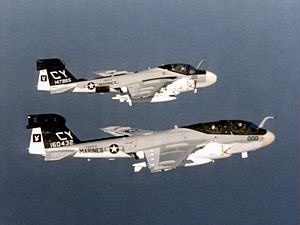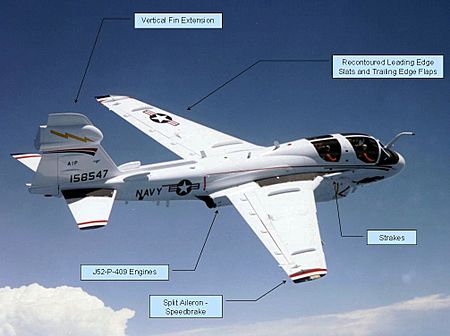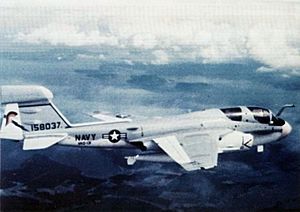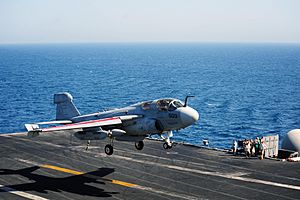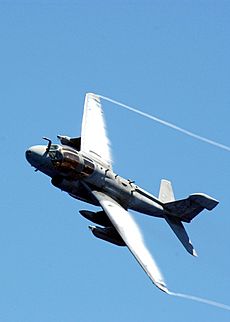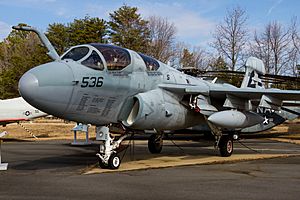Northrop Grumman EA-6B Prowler facts for kids
Quick facts for kids EA-6B Prowler |
|
|---|---|
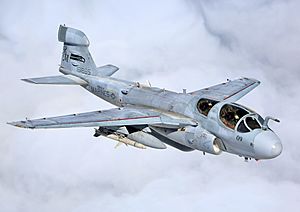 |
|
| Grumman EA-6B Prowler in flight | |
| Role | Electronic warfare/Attack aircraft |
| Manufacturer | Grumman Northrop Grumman |
| First flight | 25 May 1968 |
| Introduction | July 1971 |
| Retired | March 2019, U.S. Marine Corps |
| Status | Retired |
| Primary users | United States Navy (historical) United States Marine Corps (historical) |
| Produced | 1966-1991 |
| Number built | 170 |
| Developed from | Grumman A-6 Intruder |
The Northrop Grumman EA-6B Prowler was a special airplane used by the U.S. Navy and Marine Corps. It had two engines and four seats. This aircraft was designed for electronic warfare. This means it could jam enemy radar and communication systems. It was based on another plane called the Grumman A-6 Intruder. The Prowler also carried missiles to attack enemy radar sites.
The Prowler was used by the U.S. Armed Forces from 1971 until 2019. It flew many missions to jam enemy radar systems. It also gathered information about enemy air defense systems. After 1998, the EA-6B was the only special electronic warfare plane for the U.S. Navy, Marine Corps, and Air Force. This changed when the Navy got the Boeing EA-18G Growler in 2009. The U.S. Navy stopped using the EA-6B in 2015. The U.S. Marine Corps retired it in March 2019.
Contents
How the Prowler Was Developed
Early Versions of the Prowler
The EA-6A "Electric Intruder" was made for the U.S. Marine Corps in the 1960s. It replaced older planes like the EF-10B Skyknights. The EA-6A was a two-seat version of the Grumman A-6 Intruder. It had special electronic warfare (EW) equipment.
Three Marine Corps squadrons used the EA-6A during the Vietnam War. Only 27 EA-6As were built. Most of them were retired in the 1970s. The EA-6A was a temporary plane until the more advanced EA-6B was ready.
The EA-6B was a much more advanced plane. Its development started in 1966. It was designed to replace the EKA-3B Skywarriors for the U.S. Navy. The front part of the plane was made longer. This created a bigger cockpit for four crew members. A special antenna was added to the top of its tail.
Grumman got a contract to build an EA-6B prototype in 1966. The Prowler first flew on May 25, 1968. It started service on aircraft carriers in July 1971. A total of 170 EA-6B planes were made between 1966 and 1991.
The EA-6B Prowler had two Pratt & Whitney J52 turbojet engines. It could fly at very fast speeds, just below the speed of sound. Because it was an older plane and used a lot of electronic equipment, it needed a lot of maintenance. The EA-6B was designed for electronic warfare. It could also attack some targets on its own. This included enemy radar sites and surface-to-air missile launchers. It could also gather electronic signals intelligence.
The EA-6B Prowler was updated many times. The first update was called "expanded capability" (EXCAP) in 1973. Then came "improved capability" (ICAP) in 1976 and ICAP II in 1980. The ICAP II update allowed the EA-6B to fire Shrike missiles and AGM-88 HARM missiles.
Advanced Prowler Upgrades
The Advanced Capability EA-6B Prowler (ADVCAP) program aimed to make the EA-6B fly better. It also updated its avionics and electronic warfare systems. The plan was to change all EA-6Bs to the ADVCAP version. However, this program was stopped in 1995 due to money issues.
The ADVCAP program started in the late 1980s. It had three main parts:
- FSD: This tested a new electronic warfare system.
- VEP: This made many changes to improve how the plane flew. It fixed problems with control, especially when recovering from difficult situations.
* New parts were added to the wings and tail. * The engines were replaced with more powerful ones. * A new digital flight control system was installed.
- AIP: This was the final ADVCAP version. It included all the earlier changes. It also added new screens for the crew. The pilot got a head-up display. The plane also had new navigation systems.
After the ADVCAP program was cancelled, three experimental Prowlers were stored. In 1999, parts from these three planes were used to build one plane. The Navy called it "FrankenProwler." It returned to service in 2005.

Latest Prowler Upgrades
Northrop Grumman provided new electronic equipment for Prowler squadrons. This equipment was called ICAP III. It included a new receiver and software. This allowed for more precise radar jamming and deception. It also helped locate enemy threats better. The ICAP III sets also had the Link 16 data link system. This allowed the plane to share information with other aircraft. The EA-6B Prowlers used at the end of their service were the ICAP III version. They carried the ALQ-99 Tactical Jamming System.
Prowler Design Features
The EA-6B was designed to operate from aircraft carriers and advanced bases. It was a complete electronic warfare system. It could fly long distances in all weather. It had advanced electronic countermeasures. The plane had extra electronic equipment in a special bay and a pod on its tail. It was the main electronic warfare aircraft for the U.S. Navy and Marine Corps.
The EA-6B's main job was to help ground-attack planes. It did this by disrupting enemy electromagnetic activity. It could also gather tactical electronic intelligence in a combat zone. Another job was to attack enemy radar sites with anti-radiation missiles.
The Prowler had a crew of four: one pilot and three Electronic Countermeasures Officers (ECMOs). It was powered by two Pratt & Whitney J52-P-408A turbojet engines. It could fly up to 590 miles per hour (950 km/h). Its range was 1,140 miles (1,840 km).
A unique design feature was its refueling probe. It was bent to the right. This gave the pilot a better view than in the A-6 Intruder. The cockpit canopy had a gold tint. This protected the crew from the strong radio waves produced by the electronic warfare equipment.
Prowler's History in Action
The EA-6B started service with VAQ-129 in September 1970. VAQ-132 became the first squadron to use it in combat in July 1971. This squadron went to Vietnam on the America 11 months later. Other squadrons, VAQ-131 and VAQ-134, soon followed. Two squadrons of EA-6B Prowlers flew 720 missions during the Vietnam War. They supported U.S. Navy attack planes and U.S. Air Force B-52 bombers.
In 1983, four Prowlers supported the invasion of Grenada from the USS Independence (CV-62). In 1985, Prowlers from the USS Saratoga (CV-60) helped intercept a plane carrying hijackers. Prowlers also jammed Libyan radar during Operation El Dorado Canyon in April 1986. They also jammed Iranian radar during Operation Praying Mantis in 1988.
A total of 39 EA-6B Prowlers were used in Operation Desert Storm in 1991. They flew 4,600 hours and fired over 150 AGM-88 HARM missiles. No Prowlers were lost during these missions.
After the EF-111 Raven retired in 1998, the EA-6B was the only dedicated aerial radar jammer. This was true until the Navy got the Boeing EA-18G Growler in 2009. The EA-6B flew in almost all American combat operations from 1972 until its retirement in 2019. It often supported U.S. Air Force missions.

In 2001, 124 Prowlers were still in use. They were part of Navy, Marine, and joint Navy-Air Force squadrons. From 2004 to 2014, U.S. Air Force officers joined Navy Prowler units.
The Navy started replacing the EA-6B Prowler with the Boeing EA-18G Growler in 2009. The Growler is a new electronic warfare plane based on the Boeing F/A-18E/F Super Hornet. Most active Navy EA-6B squadrons were based at Naval Air Station Whidbey Island. VAQ-136 was in Japan. The Navy Reserve's only EA-6B squadron, VAQ-209, was in Maryland. All Marine Corps EA-6B squadrons were in Marine Corps Air Station Cherry Point, North Carolina.
The U.S. Navy planned to fly the EA-6B until 2015. The U.S. Marine Corps expected to retire the Prowler in 2019. The last Navy deployment was in November 2014. The last Navy operational flight was on May 27, 2015. The Marine Corps retired the aircraft on March 8, 2019.
Prowler Missions in Afghanistan, Iraq, and Syria
In 2007, Prowlers were used in Afghanistan. They jammed remote devices that could set off bombs. Two Prowler squadrons also worked in Iraq on the same mission. An EA-6B was also used to jam Pakistani radar during the mission to find Osama Bin Laden.
VMAQ-3 started flying Prowler missions against Islamic State militants over Iraq in June 2014. VMAQ-4 took over when Operation Inherent Resolve began in August. Prowlers were the first Marine Corps planes in Syria. They supported air strikes and electronic warfare against militants. By January 2015, VMAQ-4's five planes had flown 800 hours. They supported coalition airstrikes and helped Iraqi Army forces. Marine Prowlers did not drop bombs themselves.
In April 2016, a squadron of EA-6B Prowlers from VMAQ-4 went to Incirlik Air Base, Turkey. They flew missions over Syria. The U.S. European Command said the deployment would last until September 2016. These Prowlers may have been used to prevent Russian and Syrian air defense systems from tracking U.S. and coalition aircraft.
Prowlers from VMAQ-2 finished their last mission in November 2018. This squadron was the last to use the EA-6B. It was disbanded on March 8, 2019. Its last two Prowlers were sent to museums.
Who Used the Prowler?
The EA-6B Prowler was used by the United States Marine Corps and the United States Navy.
U.S. Marine Corps Squadrons
VMAQ squadrons used the EA-6B Prowler. Each of the three squadrons had five aircraft. These squadrons were based on land. However, they could also operate from U.S. Navy aircraft carriers.
In 2013, VMAQ-1 became a training squadron. This happened because the U.S. Navy stopped training on the Prowler. They switched to the Growler. The Marine Training squadron started training students in October 2013.
| Squadron Name | Insignia | Nickname | Dates operated | Senior Command | Station |
|---|---|---|---|---|---|
|
|
|
|
1992–2016 |
|
|
|
|
|
|
1977-2019 |
|
|
|
|
|
|
1992–2018 |
|
|
|
|
 |
|
1981–2017 |
|
|
In 2008, the Marine Corps looked into using the Lockheed Martin F-35 Lightning II for electronic attack. This would replace their Prowlers. The Marines started retiring the EA-6 in 2016. They replaced it with a new system called MAGTF-EW. This system uses unmanned aerial vehicles (drones) for some electronic warfare missions.
In November 2018, VMAQ-2 completed the last missions for USMC Prowlers. The Marines retired the aircraft on March 8, 2019. Some Prowlers were put into storage or displayed in museums.
In the U.S. Navy, four EA-6B Prowlers were usually part of a Tactical Electronic Warfare Squadron. These Navy Electronic Attack squadrons were called VAQ. Most of these squadrons were based on aircraft carriers. Others were "expeditionary" and deployed to land bases overseas.
| Squadron Name | Insignia | Nickname | Dates Operated | Carrier air wing | Station | Notes |
|---|---|---|---|---|---|---|
| VAQ-129 | Vikings | 1971–2015 | Fleet Replacement Squadron | NAS Whidbey Island | Trained both Marine, Air Force, and Navy crews in the EA-6B and the EA-18G |
|
| VAQ-130 | Zappers | 1975–2011 | CVW-3 | NAS Whidbey Island | EA-6B replaced by EA-18G | |
| VAQ-131 | Lancers | 1971–2015 | CVW-2 | NAS Whidbey Island | EA-6B replaced by EA-18G | |
| VAQ-132 | Scorpions | 1971–2009 | CVW-17 | NAS Whidbey Island | EA-6B replaced by EA-18G | |
| VAQ-133 | Wizards | 1971–2014 | CVW-9 | NAS Whidbey Island | EA-6B replaced by EA-18G | |
| VAQ-134 | Garudas | 1972–2015 | CVW-8 | NAS Whidbey Island | EA-6B replaced by EA-18G. | |
| VAQ-135 | Black Ravens | 1973–2010 | NAS Whidbey Island | EA-6B replaced by EA-18G | ||
| VAQ-136 | Gauntlets | 1973–2012 | NAS Whidbey Island | EA-6B replaced by EA-18G | ||
| VAQ-137 | Rooks | 1973–2012 | CVW-1 | NAS Whidbey Island | EA-6B replaced by EA-18G | |
| VAQ-138 | Yellow Jackets | 1976–2009 | N/A | EA-6B replaced by EA-18G | ||
| VAQ-139 | Cougars | 1983–2011 | CVW-17 | NAS Whidbey Island | EA-6B replaced by EA-18G | |
| VAQ-140 | Patriots | 1985–2014 | CVW-7 | NAS Whidbey Island | EA-6B replaced by EA-18G | |
| VAQ-141 | Shadowhawks | 1987–2009 | CVW-5 | Naval Air Facility (NAF) Atsugi | EA-6B replaced by EA-18G | |
| VAQ-142 | Gray Wolves | 1997–2015 | CVW-11 | NAS Whidbey Island | EA-6B replaced by EA-18G | |
| VAQ-209 | Star Warriors | 1977–2013 | Reserve Tactical Support Wing | NAS Whidbey Island | EA-6B replaced by EA-18G |
Prowler Accidents
No Prowler was ever lost in combat. However, nearly 50 of the 170 built were destroyed in accidents. In 1998, a memorial was built at Naval Air Station Whidbey Island. It honors 44 crew members lost in EA-6B accidents.
- On May 26, 1981, a USMC EA-6B crashed on the Nimitz flight deck. It caused a fire that killed 14 crewmen and injured 45. The crash also destroyed or damaged 19 other aircraft.
- On February 3, 1998, a USMC EA-6B Prowler from VMAQ-2 hit the cables of a cable car system in Cavalese, Italy. The crew broke rules by flying too low and fast. This caused 20 people to die. The plane was badly damaged but landed safely.
- On March 11, 2013, a USN EA-6B crashed during a training exercise in Washington State. Three crew members were killed. An investigation found that the crash was due to pilot error.
Prowler Versions
- EA-6A: This was the first electronic warfare version. Two early A-6As were changed into EA-6As as test planes. A total of 25 EA-6As were built.
- EA-6B: This was the main production version. Three A-6As were changed into EA-6Bs as test planes. A total of 170 EA-6Bs were built.
Prowlers on Display
Many EA-6B Prowlers are now on display in museums and bases.
Japan
- 160786 – EA-6B on display at Naval Air Facility Atsugi in Yamato, Kanagawa.
United States
- 147865 – EA-6A on display at Marine Corps Air Station Cherry Point in Havelock, North Carolina.
- 148618 – EA-6A on display at Naval Air Station Key West in Big Coppitt Key, Florida.
- 149475 – EA-6A on display at the Wisconsin National Guard Memorial Library and Museum at Volk Field Air National Guard Base in Camp Douglas, Wisconsin.
- 156481 – EA-6B on display at the National Naval Aviation Museum in Pensacola, Florida.
- 156478 – EA-6B on display at Naval Air Station Whidbey Island in Oak Harbor, Washington.
- 156984 – EA-6A on display at the Warner Museum of Aviation and Transportation in Sioux City, Iowa.
- 158029 – EA-6B on display at Naval Air Station Patuxent River in Lexington Park, Maryland.
- 158033 – EA-6B on display at Patuxent River Naval Air Museum in Lexington Park, Maryland.
- 158034 – EA-6B on display at Charles B. Hall Airpark at Tinker Air Force Base in Oklahoma City, Oklahoma.
- 158036 – EA-6B on display at Naval Air Station Whidbey Island in Oak Harbor, Washington.
- 158542 FrankenProwler – EA-6B on display at the Pima Air & Space Museum in Tucson, Arizona. This plane was built from parts of three different ADVCAP planes.
- 158810 – EA-6B on display at Naval Air Station Fallon in Fallon, Nevada.
- 158811 – EA-6B on display at the Pacific Coast Air Museum in Santa Rosa, California.
- 160432 – EA-6B on display at Marine Corps Air Station Cherry Point in Havelock, North Carolina.
- 160436 – EA-6B on display at the Castle Air Museum in Atwater, California.
- 160609 – EA-6B on display at Naval Air Station Jacksonville in Jacksonville, Florida.
- 161882 – EA-6B on display at the Flying Leatherneck Aviation Museum in San Diego, California.
- 161884 – EA-6B on display at the Museum of Flight in Seattle, Washington.
- 162228 – EA-6B on display at the Frontiers of Flight Museum at Dallas Love Field in Dallas, Texas.
- 162230 – EA-6B on display at the Smithsonian Institution's Steven F. Udvar-Hazy Center in Chantilly, Virginia.
- 162935 – EA-6B on display at the USS Midway Museum in San Diego, California.
- 162938 – EA-6B on display at the American Airpower Museum in Farmingdale, New York.
- 163033 – EA-6B on display at the Hickory Aviation Museum in Hickory, North Carolina.
- 163047 – EA-6B on display at the MAPS Air Museum in Akron, Ohio.
- 163395 – EA-6B on display at the United States Naval Academy in Annapolis, Maryland.
- 163886 – EA-6B on display at the Wings Over the Rockies Air and Space Museum in Denver, Colorado.
- 163890 – EA-6B on display at Naval Base Ventura County in Camarillo, California.
- 164401 – EA-6B on display at Naval Support Activity Crane in Crane, Indiana.
Prowler Specifications
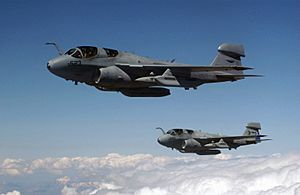

Data from US Navy Fact File, US Navy history page
General characteristics
- Crew: 4 (one pilot, three electronic countermeasures officers)
- Length: 59 ft 10 in (18.24 m)
- Wingspan: 53 ft (16 m)
- Height: 16 ft 8 in (5.08 m)
- Wing area: 528.9 sq ft (49.14 m2)
- Empty weight: 31,160 lb (14,134 kg)
- Max takeoff weight: 61,500 lb (27,896 kg)
- Powerplant: 2 × Pratt & Whitney J52-P-408A turbojet engines, 10,400 lbf (46 kN) thrust each
Performance
- Maximum speed: 566 kn (651 mph; 1,048 km/h)
- Cruise speed: 418 kn (481 mph; 774 km/h)
- Range: 2,022 nmi (2,327 mi; 3,745 km) (tanks kept)
-
-
-
- 2,400 mi (2,100 nmi; 3,900 km) (tanks dropped)
-
-
- Service ceiling: 37,600 ft (11,500 m)
- Rate of climb: 12,900 ft/min (66 m/s)
- Wing loading: 116 lb/sq ft (570 kg/m2)
- Thrust/weight: 0.34
Armament
- Hardpoints: 5 total: 1× centerline/under-fuselage plus 4× under-wing pylon stations with a capacity of 18,000 pounds (8,200 kg),with provisions to carry combinations of:
- Missiles: Up to 4× AGM-88 HARM Anti-radiation missiles (typically 2x carried)
- Other:
- Up to 5× 300 US gallons (1,100 L) external drop tanks
- Up to 5× AN/ALQ-99 Tactical Jamming System (TJS) external pods
- AN/ALE-43(V)1&4 Bulk Chaff Dispensing System pod
- AN/AAQ-28(V) Litening targeting pod (USMC only)
Avionics
- AN/ALQ-218 Tactical Jamming System Receiver
- AN/USQ-113 Communications Jamming System
See also
 In Spanish: Grumman EA-6B Prowler para niños
In Spanish: Grumman EA-6B Prowler para niños
- Aircraft related to this one
- Similar aircraft
- Boeing EA-18G Growler
- General Dynamics–Grumman EF-111A Raven
- Lists related to this aircraft
- List of active United States military aircraft


